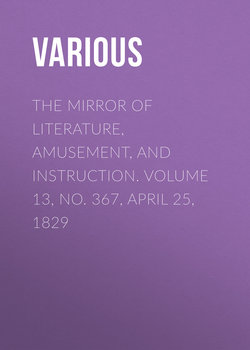Читать книгу The Mirror of Literature, Amusement, and Instruction. Volume 13, No. 367, April 25, 1829 - Various - Страница 5
SUSSEX PLACE, REGENT'S PARK
RECENT VISIT TO POMPEII
Оглавление(For the Mirror.)
For the following details respecting a city, accounts of which, (although so many are already before the public,) are always interesting, I am indebted to the oral communication of a friend which I immediately committed to paper.
M.L.B.
My object in visiting Naples was to view that celebrated relic of antiquity—the city of Pompeii, of which, about one half is now supposed to be cleared. The workmen proceed but slowly, nevertheless something is always being done, and some new remnant of antiquity is almost daily brought to light; indeed, a fine statue was discovered, almost immediately after my visit to this interesting place, but as I had quitted Naples I could not return to see it. A stranger, is I think, apt to be much disappointed in the size of Pompeii; it was on the whole, not more than three miles through, and is rather to be considered the model of a town, than one in itself. In fact, it is merely an Italian villa, or properly, a collection of villas; and the extreme smallness of what we may justly term the citizens' boxes, is another source of astonishment to those who have been used to contemplate Roman architecture in the magnificence of magnitude. Pompeii however, must always interest the intelligent observer, not more on account of its awful and melancholy associations, than for the opportunity which it affords, of remarking the extreme similarity existing between the modes of living then, and now. "'Tis Greece, but living Greece no more!" for in truth, we are enabled to surmise, from the relics of this buried and disinterred town, that manners and customs, arts, sciences, and trades, have undergone but little change in Italy since the period of its inhumation until now. In Pompeii, the shops of the baker and chemist are particularly worthy of attention, for you might really fancy yourself stepped into a modern bottéga in each of these; but, the museum of Naples, wherein are deposited most of the articles dug from Pompeii, Herculaneum, and Pæstum, is a most extraordinary lion, and one which cannot fail to affect very deeply the spectators; there you may behold furniture, arms, and trinkets; and the jewellery is, I can assure you, both in materials, pattern, and workmanship, very similar indeed to that at present in fashion, and little injured by the lapse of years, and the hot ashes under which it was buried.2 There too, you may behold various domestic and culinary utensils; and there it is quite curious to observe various jars and bottles of fruits, and pickles, evidently preserved then, the same as they are by our notable housekeepers now; of course they are blackened and incinerated, nevertheless, the forms of pears, apples, chestnuts, cherries, medlars, &c. &c. are still distinguishable. Very little furniture has been found in Pompeii; probably, because it was only occasionally resorted to as a place of residence, like our own summer haunts of the drinkers of sea and mineral waters; or, the inhabitants might have had warning of the coming misfortune, and conveyed most of their effects to a safer place; a surmise strengthened by the circumstance of so few human skeletons having been found hitherto in the town; in the museum, however, is a specimen of the inclined couch or sofa, used at meals, with tables, and other articles of furniture. The method of warming apartments by flues, and ventilating them, as now practised, was known to the inhabitants of Pompeii. Of this town, amongst public buildings, the Forum, the Theatre, and the Temple of Isis, have been discovered; and the latter has revealed, in a curious manner, the iniquitous jugglery of the heathen priests. The statue of Isis, was, it seems, oracular, and stood on a very high pedestal, or kind of altar in the temple of the goddess. Within this pedestal a flight of steps has been discovered, ascending to a metal tube or pipe; which, fixed in the hollow body of the statue, and attached to its lips, the priest of Isis was enabled by speaking through this tube, to make the poor deluded multitude believe that their idol gave articulate answers to their anxious queries! We have heard of similar delusions being practised by Christian priests, in days comparatively modern! But, only let us conceive, the shame and dismay which would now
2
"Witness," said my friend, "the bracelets which I am now wearing; they are modelled from a pair found in Pompeii." These were made of gold, quite in the fashion of the present day; beautifully chased, but by no means of an uncommon pattern.
